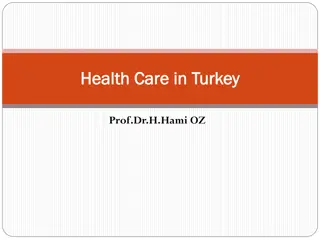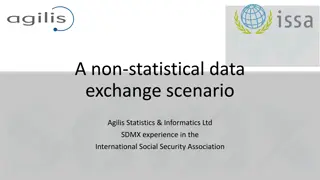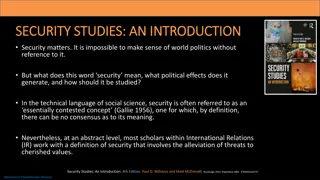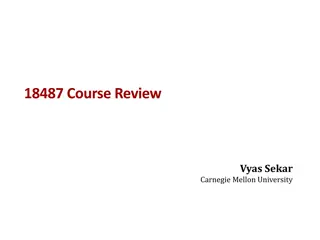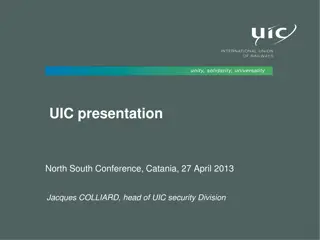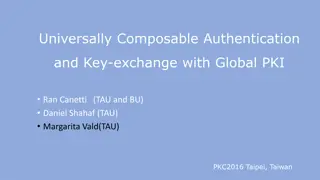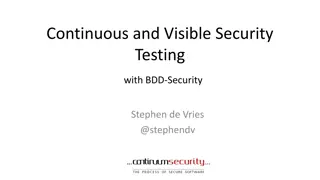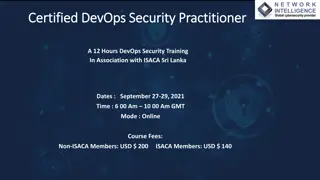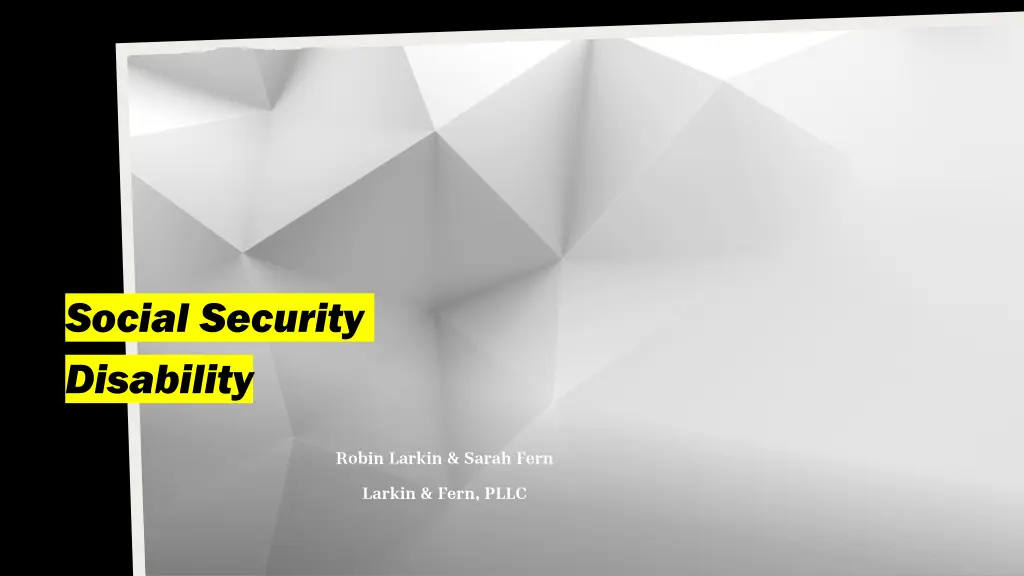
Social Security Disability Process Overview
Learn about the Social Security Disability process, including the definition of disability, eligibility criteria, application filing, review process, and representation for appeals. Understand the Sequential Evaluation steps and the benefits available under Titles II and XVI. Get insights into how disability determinations are made and the stages involved in the review process.
Download Presentation

Please find below an Image/Link to download the presentation.
The content on the website is provided AS IS for your information and personal use only. It may not be sold, licensed, or shared on other websites without obtaining consent from the author. If you encounter any issues during the download, it is possible that the publisher has removed the file from their server.
You are allowed to download the files provided on this website for personal or commercial use, subject to the condition that they are used lawfully. All files are the property of their respective owners.
The content on the website is provided AS IS for your information and personal use only. It may not be sold, licensed, or shared on other websites without obtaining consent from the author.
E N D
Presentation Transcript
Social Security Disability Robin Larkin & Sarah Fern Larkin & Fern, PLLC
Definition of Disability Title 42 U.S.C. 423(a) Title 42 U.S.C. 1382c(3)(A) The inability to engage in any substantial gainful activity by reason of any medically determinable physical or mental impairment which can be expected to result in death, or which has lasted or can be expected to last for a continuous period of not less than 12 months.
Social Security Disability Title II Retirement, Survivors, and Disability Insurance + If qualified, monthly payments to: Disabled, insured worker who has not reached full retirement age Retired, insured worker age 62 or older Spouse of a retired or disabled worker Divorced spouse of a retired or disabled worker Dependent of a retired, disabled, or deceased worker In some cases, stepchildren or parents of a deceased worker Title XVI Supplemental Security Income + Cash assistance to those who Have income and resources under certain limits, AND Are 65 or older, are blind, or are disabled.
Sequential Evaluation 20 C.F.R. 404.1520(A)(4) Series disabled or not disabled at each step, the evaluation concludes. If agency cannot determine disabled or not disabled, the evaluation continues. of five steps that are followed to determine disability eligibility. If 1. Is the claimant working? 2. Does the claimant have a severe impairment? 3. Is the impairment so severe it can be presumed that the claimant could not engage in work activity? (Does the impairment meet or equal a SS Listing of Impairments?) + 3A. What is the most the claimant can do or not do with their impairment(s)? Determine the claimant s residual functional capacity (RFC). 4. Can the claimant do their past work? 5. Can the claimant do any other work?
The Review Process SSA Application filing Title II online or in person Title XVI- only in person but soon available to apply online Disability Determination Services (DDS) (state agencies tasked with reviewing SS Disability claims) Initial review Reconsideration review ALJ hearing Appeals Council USDC Ninth Circuit
Social Security Clinic Issues Representation for appeal in federal court Continuing Disability Reviews (CDRs) Overpayments
Appeal in Federal Court At this point in the claimant s case, they have been denied disability benefits four times within the agency (initial consideration, reconsideration, hearing level (ALJ decision), and at the Appeal Council). The USDC appeal deadline is 60 days from the date of the Appeals Council denial. A claimant can file a subsequent application for disability benefits while a federal court appeal is pending on the original application. The alleged onset date of disability on the subsequent unfavorable decision. application cannot invade the prior The Appeals Council denial is usually more of a formality and will not contain substantive issues to appeal. Look to the Administrative Law Judge s unfavorable decision (from the hearing level) to determine potential USDC appeal issues.
Representation in Federal Court Briefing Supplemental Rules for Social Security Actions under 42 U.S.C. 405(g), which lists the briefing deadlines. (30, 30, 14) requirements can be found in LRCiv 16.1 and the Potential federal court outcomes: + Affirmance of the unfavorable decision denying benefits. + Remand for further proceedings (vacates the prior unfavorable decision and sends the case back to the usually a new hearing and a new ALJ decision). agency for further proceedings + Remand for calculation of benefits.
Briefing Essentials The brief: local rules require five sections for the opening + Statement of the Issues presented for review. + Statement of the Case (procedural history). + Statement of Facts (must include Plaintiff s age, education and work experience, and include a summary or outline of Plaintiff s medical impairments, treatment, and other relevant evidence, including summary of medical opinions, hearing testimony, and ALJ decision). + Argument + Conclusion stating relief sought (RFFP/RFPB).
Standard of Review Overall case standard of review: a reviewing court may properly uphold the Commissioner s decision only if that decision is both free from reversible legal error and supported by substantial evidence. + Substantial evidence is more than a mere scintilla, but still such relevant evidence as a reasonable mind might conclusion. Biestek v. Berryhill, 139 S.Ct 1148, 1154 (2019). accept as adequate to support a + A reviewing court weighs both the evidence that supports and detracts from the agency decision and may not properly affirm the ALJ decision based on ground upon which the ALJ did not rely.
Issue Spotting ALJ Decisions for USDC Appeals ALJ evaluation decisions are organized around the five-step sequential Main areas of ALJ legal error: + Evaluating Medical Opinions + Evaluating the Claimant s Symptom Testimony + RFC determination issues + Vocational/Step 5 Issues + Finding impairments not severe
Evaluating Medical Opinions Ignoring/failing to discuss a medical opinion Failing to provide sufficient reasons/rationale to reject a treating or examining opinion that supports disability + Comparison of medical evidence to assessed limitations + Improvement of symptoms + Claimant s activities of daily living
Standard of Review Legal error: evaluation of medical opinions. + March 27, 2017 to current: ALJs are required to articulate the persuasiveness of each medical opinion providing an explanation supported by substantial evidence and addressing at least two factors supportability and consistency. 20 CFR 404.1520c. + Claims filed prior to March 27, 2017 (20 CFR 404.1527): An ALJ must provide at least specific and legitimate reasons based on substantial evidence in the physician medical opinion. record to reject a treating
Evaluating the Claimants Symptom Testimony Comparison of medical evidence to symptom testimony (many issues here) Activities of Daily Living Improvement of symptoms with treatment Course of treatment/conservative treatment Claimant s statements to agency that are inconsistent with statements to medical providers Noncompliance with treatment
Standard of Review Legal error: rejection of claimant s symptom testimony. + If there is an underlying medically determinable impairment that could reasonably be expected to produce a claimant s symptoms, in the absence of affirmative evidence of malingering, a claimant s testimony may only be rejected on the basis of specific, clear and convincing reasons supported by substantial evidence in the record as a whole. Brown-Hunter v. Colvin, 806 F.3d 487, 488-89 (9th Cir. 2015). + The S/C/C standard was recently confirmed O Malley, 95 F.4th 1194, 1199 (March 14, 2024). by the Ninth Circuit in Ferguson v. + Ninth identify specific testimony that was not credible and cite to specific evidence that undermines or shows an inconsistency with that testimony. Smartt v. Kijakazi, 53 F.4th 489 (9th Cir. 2022); Ghanim v. Colvin, 763, F.3d 1154 (9th Cir. 2014); Burrell v. Colvin, 775 F.3d 1133 (9th Cir. 2014). Circuit case law requires an ALJ show their work, where the ALJ must
Other Issues + RFC determination issues Finding an stemming determination, i.e., mental health issue that affects the ability to function at a job that requires dealing with the public impairment from severe severe but impairment failing to include the limitations claimant s that in RFC + Vocational/Step 5 Issues Finding the claimant can do other work at step 5 that is not available in significant numbers in the national economy + Finding impairments are not severe In spite of evidence of an impairment that would cause more than a minimal effect on the claimant s ability to sustain work
Continuing Disability Reviews The Social Security Act authorizes the agency to perform periodic reviews for the purpose of continuing disability, at least once every three years for individuals with nonpermanent disabilities, and at a time determined by the Commissioner to be appropriate for individuals with permanent disabilities. A CDR is to determine if an individual entitled (and receiving) disability benefits continues to be disabled. They are looking for medical improvement and/or work activity. SSA will notify the claimant of the CDR, and the claimant or representative may submit medical and other evidence for consideration. The purpose of the review is to determine if an individual s impairment(s) has improved since the most recent favorable determination (called the Comparison Point Decision, CPD). The final decision of a CDR could result in a termination of benefits if SSA determines the individual s impairments have improved to allow for performance of substantial gainful activity (SGA). DI 28001.011 (Program Operations Manual System, POMS)
Overpayments Overpayments occur when a beneficiary has received more benefits than they were entitled to receive. Common reasons for overpayments: SSDI work-related cessations, medical cessations, SSI excess income, or failure to report income or resources. resources, SSI excess earned The following individuals can be held liable for an overpayment: the beneficiary, the eligible spouse, auxiliary beneficiaries, the estate of a deceased beneficiary or spouse, an immigrant s sponsor, or a representative payee. POMS GN 02201.001, 20 C.F.R. 416.437
Handling Overpayments Can the individual request a write-off for the overpayment? + SSI must write off a debt that is at least 2 years delinquent. POMS GN 02215.235(C)(2)(d). + A write off can be requested by sending a written request to the local SSA office that includes: (1) the date of the last triggering event (i.e., the date the debt was established, the date of last voluntary payment, etc.), (2) a mention of the relevant POMS section, and (3) a request that written off. the debt be
Handling Overpayments Can the overpayment be appealed (used to challenge the fact of and/or amount of an overpayment)? + A Request for Reconsideration (form SSA 561-U2) must be filed within 60 days of receipt of the notice. + Collection efforts may begin 30 days after the notice of overpayment is received, but they must cease once a Request for Reconsideration has been filed and must not be reinstated until SSA issues a decision. + After a reconsideration, a challenge to the fact of and/or amount of the overpayment should follow the process. standard administrative appeal
Handling Overpayments Can the overpayment be waived? + Use SSA-632-BK (09-2023) to request a waiver of an overpayment. + Waiver of recovery: used when an overpayment exists but the consumer states that it was not their fault, and they cannot afford to pay it back. + Requirements for a waiver: The beneficiary must be without fault (definition at 20 CFR 404.507 and 416.552) and It will defeat the program purposes to collect the overpayment because the beneficiary cannot afford to repay without risking their ability to provide for basic needs (more information about ability to pay at POMS GN02250.100 (DIB) and POMS SI 02260.020 (SSI)).
Overpayments When the decision on write-off, appeal, or waiver of an overpayment is unfavorable, look to help the claimant obtain a reasonable repayment agreement. + Use SSA-634 (12-2023) form to request a change in the overpayment recovery rate. See POMS GN 02210.030. + When this forms is filed, collection will remain the same until the form and change in circumstances are considered and a decision is made. Attorneys should nudge the Claims Specialist at the local office to resolve the matter quickly. + SSA can accept repayments as low as $10/month.
Questions? Robin Larkin & Sarah Fern Larkin & Fern, PLLC (602) 550-3744








